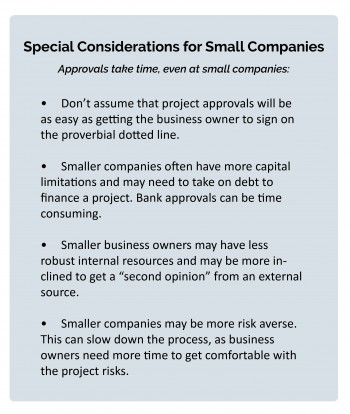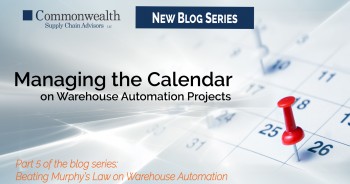Commonwealth Supply Chain Advisors recently published a ground-breaking white-paper titled, “Beating Murphy’s Law in Warehouse Automation Projects.” The full paper examines a number of the reasons why automation projects fail to meet expectations, and what companies can do to beat Murphy’s Law. This blog is fifth in an ongoing series on “Beating Murphy’s Law in Warehouse Automation Projects.
Many companies set themselves up for failure early on by committing to an unmovable deadline for completing the project. The most common reasons for this are:
- Facility exits: The timeline is based around a date when the company must exit an existing facility
- Seasonality: The timeline is based on the need to have the system operational in time for a peak period (often around the Christmas holiday season).
- 3PL contract expiration: The timeline is based on transitioning away from a third-party logistics provider on a certain date.
The deadline may be set far enough in advance that the company believes it is easily attainable. Then, Murphy’s Law begins to play out, and the timeline is extended by unforeseen circumstances. Faced with the seemingly unmovable deadline, the company then marches inexorably towards a go-live date that becomes more and more risky with each passing day. Executives issue ultimatums. Project managers are offered carrots or threatened with sticks based on achieving the timetable. Key stakeholders feel increasing pressure to “launch the boat” while workers are still patching up holes in the hull.
All of these pressures often cause the project leaders to decide to move forward with the go-live, even though all the indications are that the technology is not yet fully tested and ready- sometimes with catastrophic results. Executives may fear the impact of a delayed launch, but be blind to the far greater consequences of a premature, failed launch (remember, it’s too late to bring the boat back to the shipyard after it’s sunk to the bottom of the harbor!).

So, what can be done to resist this pressure for a premature go-live?
- Estimate the timetable accurately: To begin with, project planners should research the actual time it will take to complete the project.
- Don’t ignore design and vendor selection time: Companies often under-estimate the time it will take to fully design the system and conduct a thorough vendor selection process (these two steps alone can take six months or more on complex material handling systems).
- Approvals always take longer than expected: Executive approvals for capital-intense warehouse automation projects are rarely obtained in a matter of days, even at small companies with streamlined decision-making processes. Obtaining capital request approvals, negotiating details of contracts, and performing legal reviews can take weeks or months- not days. This process is often repeated multiple times: once for the overall project budget approval and again each time large vendor contracts are to be executed. Time for this should be built into the timetable from the beginning.
- Manufacturing lead times can change: In busier economic periods, manufacturing lead times can be much longer than in slower times. Don’t assume that vendors can manufacture equipment as quickly as they may have done during the last project you worked on. Get updated manufacturing time estimates prior to presenting any project timetable to the management team.
Add contingency time: Remember, it is usually difficult or impossible to anticipate when Murphy’s Law will strike. Add contingency time to the project schedule, even if the weather seems good and it looks like clear sailing ahead.
Have a backup plan to extend the deadline: In most of the scenarios cited above (facility exits, peak periods, 3PL contract expirations), the deadline is often not truly “unmovable”. Lease extensions can be negotiated, penalty clauses can be enacted and paid, overflow facilities and temporary labor can be hired to survive peak periods, and 3PL contracts can be renegotiated. While all of these alternatives can be costly, they may be vastly less expensive than having a failed project with product unable to ship. Additionally, if the backup plan is developed early enough, it may be possible to negotiate more favorable terms than if the discussions are held at the last minute under emergency circumstances.
To read Commonwealth’s complete white-paper titled, Beating Murphy’s Law in Warehouse Automation Projects, click here.

